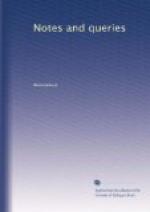It is, perhaps, as well to state that there were some fifteen to twenty persons standing around the smouldering embers at the time I passed.
Senex.
India Rubber is now so cheap and common, that it seems worth while to make a note of the following passage in the Monthly Review for Feb. 1772. It occurs at p. 71., in the article on “A familiar Introduction to the Theory and Practice of Perspective, by Joseph Priestly, LL.D. F.R.S., 8vo. 5s., boards. Johnson.”
“Our readers, perhaps, who employ themselves in the art of drawing, will be pleased with a transcript of the following advertisement:—’I have seen, says Dr. Priestly, a substance, excellently adapted to the purpose of wiping from paper the marks of a black lead pencil. It must, therefore, be of singular use to those who practise drawing. It is sold by Mr. Nairne, mathematical instrument-maker, opposite the Royal Exchange. He sells a cubical piece, of about half an inch, for three shillings; and, he says, it will last several years.’”
N.B.
* * * * *{166}
QUERIES
THE “BAR” OF MICHAEL ANGELO.
In that delightful volume, In Memoriam, in which Mr. Tenyson has so nobly and pathetically enshrined the memory of his friend, Arthur Hallam, the following passage occurs, pp. 126, 127.:—
“To these conclusions, when we saw
The God within him light his face,
And seem to lift the form, and glow
In azure orbits heavenly-wise;
And over those ethereal eyes
The bar of Michael Angelo.”
To what does this allude? In the fine profile portrait by Julio Bonasoni, Michael Angelo appears to have had a protuberant brow; and Condivi says, in his very interesting and detailed account of his person, that his forehead was square, and that, seen in profile ("quasi avanza il naso"), it projected almost beyond the nose. It is remarkable that the same spirit pervades these verses which we find in the Platonic breathings of the Rime of the great artist; but we are most forcibly reminded of the poet of Vaucluse. The grief of the poet for the loss of his friend has however had a happier effect on his mind than the more impassioned nature of that of the lover of Laura produced: yet a kindred feeling, of spiritual communion with the lost one, pervades both poets; and this might have been the motto of Mr. Tenyson’s volume:—
“Levommi il mio pensiero in parte ov’ era Quello eh’ io cerco, e non ritrovo in terra; ... in questa spera Sarai ancor meco, s’ el desir non erra.”
Foscolo has remarked that “when a great poet describes his own heart, his picture of Love will draw tears from the eyes of every sensitive mortal in every age.” And no one can read these effusions of deepfelt virtuous affection without emotions of a happy tendency.




